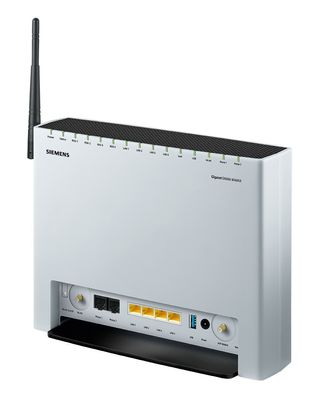Where's WiMAX? THG Gets The Story From Clearwire
WiMAX Moving Forward

TH: What factors influence where you target for your next WiMAX rollouts?
JS: Well, I think one of the biggest factors is our investor group. Comcast, Time Warner, Google, and Intel certainly are big influencers in where we head by the investment that they’ve made in the company as well as their positions on the board. Then there’s customer demand—where the customers are telling us that they’re going, where they’d like to go. From Baltimore, it’s pretty obvious they’re going to D.C., but it’s also interesting how some of the feedback we’re receiving says they’re going to Boston or Philly or even Atlanta.
TH: What are the maximum capabilities of a WiMAX network?

JS: The maximum capability of WiMAX has yet to be determined. WiMAX comes in 5, 10, and 20 MHz flavors. We’re currently operating the 10 MHz flavor. It has the capability of going to 20 MHz, which will bring with it capacity as well as further capabilities. Some of that is still in standards development. One of the best ways we can increase bandwidth over time on our networks is through augmentation of the sites. If the issue is just pure traffic volume, we add channels to the site. We have very deep spectrum positions in the 2.5 GHz band we operate, so it’s very easy for us to be able to build up additional capacity in an area over a group of sites. On the other hand, if it’s a volume of activity that’s occurring in an area, we may go to cell splitting and add in additional sites that will improve coverage and capacity.
TH: Clearwire states a 6 Mbps download rate, and I’ve clocked it up over 9 Mbps. Is it realistic to think that if all goes well, each user is going to start seeing at least 10 Mbps speeds?
JS: We’re setting the expectation that the service level we’re going to deliver is that 6 Mbps experience you signed up for. But we’re not going to cap you there. If the network can carry some greater capacities within limitations, we’re going to let you have that burstable moment because there’s no reason to hold it back from you. Now, going back to the user trials we did in the early days, we intentionally concentrated users at one factory on WiMAX so we could really load down sectors with random traffic. You can simulate all the traffic you want, but until you get in real user hands, you don’t get what true demand is going to look like. But through those loading experiences with live end users doing whatever they wanted, we were able to design our sites with the needed capacity throughput.

TH: How will Clearwire’s services change or grow over time?
Stay on the Cutting Edge
Join the experts who read Tom's Hardware for the inside track on enthusiast PC tech news — and have for over 25 years. We'll send breaking news and in-depth reviews of CPUs, GPUs, AI, maker hardware and more straight to your inbox.
JS: Early cell phones had 10 keys and a send and an end button, really no display or anything. That’s where we are in our technology evolution. We’re displacing the Wi-Fi hotspot, the DSL connection, and things of that nature. I think some of the first levels of evolution are around location-based services. Where things tend to be ramping up a bit more is the whole mobility environment, whether it be the social stuff like Twitter or MeetMe or whatever. You’re going to see adaptations to that go to the smaller device but with a richer experience—a PDA that truly has a broadband connection and allows for real-time imaging experiences or things of that nature.
TH: Is WiMAX going to function as a VoIP vehicle? If all goes according to plan, is this how I’m going to be communicating everywhere five years from now?
JS: We certainly hope so. It’s already a VoIP platform today. How should I say this? We hope and expect that this will be your enriched telecommunications platform in the same way that your cell phone has become almost your primary telephone. Keep in mind that we’re not there yet when it comes to mobile VoIP. That’s part of the strategy, but we don’t have a timeline for putting that out there.
TH: Going back to one of your earlier comments about latency, am I going to be facing any longer time lags on WiMAX voice communications versus cellular, or is it pretty much indistinguishable?
JS: The Internet is indiscriminate about traffic, whether it be a voice packet, an image, or streaming video or something of that nature. Specific to the airlink, devices communicate that this is a VoIP packet. We manage that in an asynchronous pattern, so that way it doesn’t develop some of the latency and jitters you might have seen from VoIP services such as Skype or Vonage that have to ride and contend with the rest of the network traffic. We handle VoIP packets separately from regular Internet traffic. That allows it to have its own higher level of quality service—a little bit less about bandwidth and more about latency management, which is kind of a new aspect.
-
fwaynedavis Rural is a tough market, but Clearwire does a good job of pushing tech out early in small markets, I know from experience. In most cases they are the only game in town. But Wimax will be very slow to come to rural unless prices drop, this stuff costs a fortune.Reply -
brandnewx In Cambodia, the wireless network standards are already WiMax and 3G. In fact, I'm using both technologies in my home office for two years now.Reply -
AncientToaster My family lives in Portland, and we got Clear when it rolled out at the introductory price of $25/month. It rocks--much faster then 3G, and much, much cheaper then traditional broadband. In our area the only broadband available besides Clear and 3G is cable, at twice the price.Reply -
hellwig Doesn't handling VOIP traffic separately make it a telephone network subject to the same rules and regulations as a traditional telephone provider? Isn't Comcast getting in trouble for providing a special network for their cable phone service?Reply
I can't believe I've been hearing so much about WiMax (which devices support it, complaint when some devices don't support it), when it only exists in two U.S. markets. It's bad enough that 3G coverage is so spotty, like we need another, even sparser service. -
scryer_360 Thanks to Toms for the interview, we consumers now know more.Reply
But I wonder: why didn't you talk to him about the differences between WiMax and LTE? Both are all packet designed apps, but LTE is (apparently) the future of US data communications, according to some. I'd like to see Clearwire's vision of high speed wireless data being the best, but I can't without some input on their choice to do WiMax over LTE. -
nachowarrior South Carolina was supposed to go statewide, but it's biggest cable broadband server allegedly paid them off, oh, and was also somehow allowed to operate in one of it's biggest cities for two years illegally, without a lisence, and owe 2 million to the state before anything came up.... and this came up about the same time the state wanted to roll out statewide free coverage... hmmmm... I WONDER WHAT HAPPENED??? anyway, just another disappointment thanks to politics and money lubing the gears.Reply -
strider209 I had clearwire when I lived in the outskirts of Tracy, CA. My only other choices were dial-up or satellite. Both were of course slower than clearwire. The ability to be portable was nice, but I never used it. My best speeds were around 3Mbps but there was quite a bit of latency. For me, clearwire was my best option and decently priced, but if it was available I would prefer DSL or cable.Reply
Most Popular

